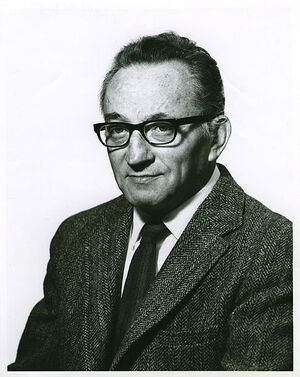Spiegelman's Monster (nonfiction): Difference between revisions
(Created page with "thumb|Sol Spiegelman.'''Spiegelman's Monster''' is the name given to an RNA chain of only 218 nucleotides that is able to be reproduced by an RNA re...") |
No edit summary |
||
| (One intermediate revision by the same user not shown) | |||
| Line 1: | Line 1: | ||
[[File: | [[File:Sol_Spiegelman.jpg|thumb|Sol Spiegelman.]]'''Spiegelman's Monster''' is the name given to an RNA chain of only 218 nucleotides that is able to be reproduced by an RNA replication enzyme. It is named after its creator, Sol Spiegelman, of the University of Illinois at Urbana-Champaign. | ||
== Description == | == Description == | ||
| Line 18: | Line 18: | ||
== Fiction == | == Fiction == | ||
* [[Serpin]] | |||
== External links == | == External links == | ||
Latest revision as of 05:04, 4 June 2016
Spiegelman's Monster is the name given to an RNA chain of only 218 nucleotides that is able to be reproduced by an RNA replication enzyme. It is named after its creator, Sol Spiegelman, of the University of Illinois at Urbana-Champaign.
Description
Spiegelman introduced RNA from a simple bacteriophage Qβ (Qβ) into a solution which contained Qβ's RNA replication enzyme, some free nucleotides, and some salts. In this environment, the RNA started to be replicated.
After a while, Spiegelman took some RNA and moved it to another tube with fresh solution. This process was repeated.
Shorter RNA chains were able to be replicated faster, so the RNA became shorter and shorter as selection favored speed. After 74 generations, the original strand with 4,500 nucleotide bases ended up as a dwarf genome with only 218 bases. Such a short RNA had been able to be replicated very quickly in these unnatural circumstances.
In 1997, Eigen and Oehlenschlager showed that the Spiegelman monster eventually becomes even shorter, containing only 48 or 54 nucleotides, which are simply the binding sites for the reproducing enzyme RNA replicase.
M. Sumper and R. Luce of Eigen's laboratory demonstrated that a mixture containing no RNA at all but only RNA bases and Qβ replicase can, under the right conditions, spontaneously generate self-replicating RNA which evolves into a form similar to Spiegelman's Monster.[5] Note that despite the term self-replicating RNA, the RNA did not replicate itself: the Qβ enzyme is what made the RNA molecules.
Nonfiction cross-reference
Fiction
External links
- Spiegelman's Monster @ Wikipedia
